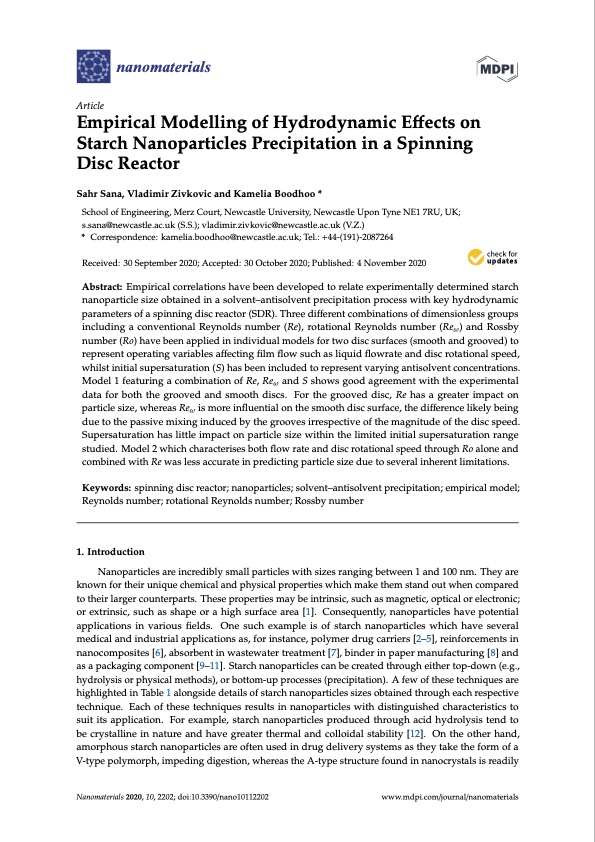
PDF Publication Title:
Text from PDF Page: 001
nanomaterials Article Empirical Modelling of Hydrodynamic Effects on Starch Nanoparticles Precipitation in a Spinning Disc Reactor Sahr Sana, Vladimir Zivkovic and Kamelia Boodhoo * School of Engineering, Merz Court, Newcastle University, Newcastle Upon Tyne NE1 7RU, UK; s.sana@newcastle.ac.uk (S.S.); vladimir.zivkovic@newcastle.ac.uk (V.Z.) * Correspondence: kamelia.boodhoo@newcastle.ac.uk; Tel.: +44-(191)-2087264 Received: 30 September 2020; Accepted: 30 October 2020; Published: 4 November 2020 Abstract: Empirical correlations have been developed to relate experimentally determined starch nanoparticle size obtained in a solvent–antisolvent precipitation process with key hydrodynamic parameters of a spinning disc reactor (SDR). Three different combinations of dimensionless groups including a conventional Reynolds number (Re), rotational Reynolds number (Reω) and Rossby number (Ro) have been applied in individual models for two disc surfaces (smooth and grooved) to represent operating variables affecting film flow such as liquid flowrate and disc rotational speed, whilst initial supersaturation (S) has been included to represent varying antisolvent concentrations. Model 1 featuring a combination of Re, Reω and S shows good agreement with the experimental data for both the grooved and smooth discs. For the grooved disc, Re has a greater impact on particle size, whereas Reω is more influential on the smooth disc surface, the difference likely being due to the passive mixing induced by the grooves irrespective of the magnitude of the disc speed. Supersaturation has little impact on particle size within the limited initial supersaturation range studied. Model 2 which characterises both flow rate and disc rotational speed through Ro alone and combined with Re was less accurate in predicting particle size due to several inherent limitations. Keywords: spinning disc reactor; nanoparticles; solvent–antisolvent precipitation; empirical model; Reynolds number; rotational Reynolds number; Rossby number 1. Introduction Nanoparticles are incredibly small particles with sizes ranging between 1 and 100 nm. They are known for their unique chemical and physical properties which make them stand out when compared to their larger counterparts. These properties may be intrinsic, such as magnetic, optical or electronic; or extrinsic, such as shape or a high surface area [1]. Consequently, nanoparticles have potential applications in various fields. One such example is of starch nanoparticles which have several medical and industrial applications as, for instance, polymer drug carriers [2–5], reinforcements in nanocomposites [6], absorbent in wastewater treatment [7], binder in paper manufacturing [8] and as a packaging component [9–11]. Starch nanoparticles can be created through either top-down (e.g., hydrolysis or physical methods), or bottom-up processes (precipitation). A few of these techniques are highlighted in Table 1 alongside details of starch nanoparticles sizes obtained through each respective technique. Each of these techniques results in nanoparticles with distinguished characteristics to suit its application. For example, starch nanoparticles produced through acid hydrolysis tend to be crystalline in nature and have greater thermal and colloidal stability [12]. On the other hand, amorphous starch nanoparticles are often used in drug delivery systems as they take the form of a V-type polymorph, impeding digestion, whereas the A-type structure found in nanocrystals is readily Nanomaterials 2020, 10, 2202; doi:10.3390/nano10112202 www.mdpi.com/journal/nanomaterialsPDF Image | Hydro Starch Nanoparticles Precip Spinning Disc Reactor

PDF Search Title:
Hydro Starch Nanoparticles Precip Spinning Disc ReactorOriginal File Name Searched:
nanomaterials-10-02202-v2.pdfDIY PDF Search: Google It | Yahoo | Bing
Turbine and System Plans CAD CAM: Special for this month, any plans are $10,000 for complete Cad/Cam blueprints. License is for one build. Try before you buy a production license. More Info
Waste Heat Power Technology: Organic Rankine Cycle uses waste heat to make electricity, shaft horsepower and cooling. More Info
All Turbine and System Products: Infinity Turbine ORD systems, turbine generator sets, build plans and more to use your waste heat from 30C to 100C. More Info
CO2 Phase Change Demonstrator: CO2 goes supercritical at 30 C. This is a experimental platform which you can use to demonstrate phase change with low heat. Includes integration area for small CO2 turbine, static generator, and more. This can also be used for a GTL Gas to Liquids experimental platform. More Info
Introducing the Infinity Turbine Products Infinity Turbine develops and builds systems for making power from waste heat. It also is working on innovative strategies for storing, making, and deploying energy. More Info
Need Strategy? Use our Consulting and analyst services Infinity Turbine LLC is pleased to announce its consulting and analyst services. We have worked in the renewable energy industry as a researcher, developing sales and markets, along with may inventions and innovations. More Info
Made in USA with Global Energy Millennial Web Engine These pages were made with the Global Energy Web PDF Engine using Filemaker (Claris) software.
Infinity Turbine Developing Spinning Disc Reactor SDR or Spinning Disc Reactors reduce processing time for liquid production of Silver Nanoparticles.
| CONTACT TEL: 608-238-6001 Email: greg@infinityturbine.com | RSS | AMP |